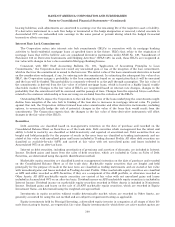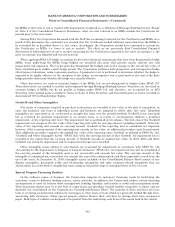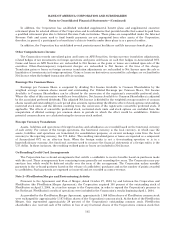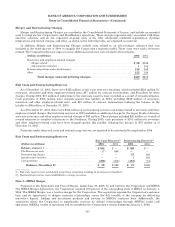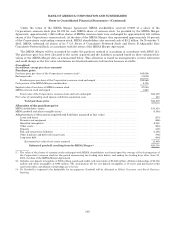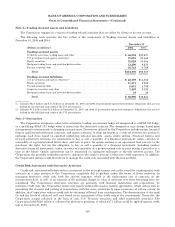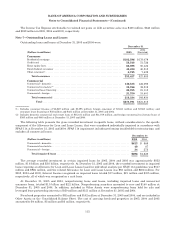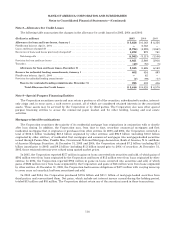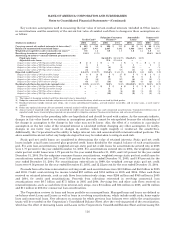Bank of America 2005 Annual Report Download - page 145
Download and view the complete annual report
Please find page 145 of the 2005 Bank of America annual report below. You can navigate through the pages in the report by either clicking on the pages listed below, or by using the keyword search tool below to find specific information within the annual report.
BANK OF AMERICA CORPORATION AND SUBSIDIARIES
Notes to Consolidated Financial Statements—(Continued)
Note 4—Trading Account Assets and Liabilities
The Corporation engages in a variety of trading-related activities that are either for clients or its own account.
The following table presents the fair values of the components of Trading Account Assets and Liabilities at
December 31, 2005 and 2004.
December 31
(Dollars in millions) 2005 2004
Trading account assets
Corporate securities, trading loans and other ....................................... $ 46,554 $35,227
U.S. government and agency securities(1) ........................................... 31,091 20,462
Equity securities ................................................................ 31,029 19,504
Mortgage trading loans and asset-backed securities .................................. 12,290 9,625
Foreign sovereign debt ........................................................... 10,743 8,769
Total ...................................................................... $131,707 $93,587
Trading account liabilities
U.S. government and agency securities(2) ........................................... $ 23,179 $14,332
Equity securities ................................................................ 11,371 8,952
Foreign sovereign debt ........................................................... 8,915 4,793
Corporate securities and other .................................................... 7,407 8,538
Mortgage trading loans and asset-backed securities .................................. 18 39
Total ...................................................................... $ 50,890 $36,654
(1) Includes $22.1 billion and $17.3 billion at December 31, 2005 and 2004 of government-sponsored enterprise obligations that are not
backed by the full faith and credit of the U.S. government.
(2) Includes $1.4 billion and $1.2 billion at December 31, 2005 and 2004 of government-sponsored enterprise obligations that are not
backed by the full faith and credit of the U.S. government.
Note 5—Derivatives
The Corporation designates a derivative as held for trading, an economic hedge not designated as a SFAS 133 hedge,
or a qualifying SFAS 133 hedge when it enters into the derivative contract. The designation may change based upon
management’s reassessment or changing circumstances. Derivatives utilized by the Corporation include swaps, financial
futures and forward settlement contracts, and option contracts. A swap agreement is a contract between two parties to
exchange cash flows based on specified underlying notional amounts, assets and/or indices. Financial futures and
forward settlement contracts are agreements to buy or sell a quantity of a financial instrument, index, currency or
commodity at a predetermined future date, and rate or price. An option contract is an agreement that conveys to the
purchaser the right, but not the obligation, to buy or sell a quantity of a financial instrument (including another
derivative financial instrument), index, currency or commodity at a predetermined rate or price during a period or at a
time in the future. Option agreements can be transacted on organized exchanges or directly between parties. The
Corporation also provides credit derivatives to customers who wish to increase or decrease credit exposures. In addition,
the Corporation utilizes credit derivatives to manage the credit risk associated with the loan portfolio.
Credit Risk Associated with Derivative Activities
Credit risk associated with derivatives is measured as the net replacement cost in the event the counterparties with
contracts in a gain position to the Corporation completely fail to perform under the terms of those contracts. In
managing derivative credit risk, both the current exposure, which is the replacement cost of contracts on the
measurement date, as well as an estimate of the potential change in value of contracts over their remaining lives are
considered. The Corporation’s derivative activities are primarily with financial institutions and corporations. To
minimize credit risk, the Corporation enters into legally enforceable master netting agreements, which reduce risk by
permitting the closeout and netting of transactions with the same counterparty upon occurrence of certain events. In
addition, the Corporation reduces credit risk by obtaining collateral from counterparties. The determination of the need
for and the levels of collateral will vary based on an assessment of the credit risk of the counterparty. Generally, the
Corporation accepts collateral in the form of cash, U.S. Treasury securities and other marketable securities. The
Corporation held $24.9 billion of collateral on derivative positions, of which $17.1 billion could be applied against credit
risk at December 31, 2005.
109



